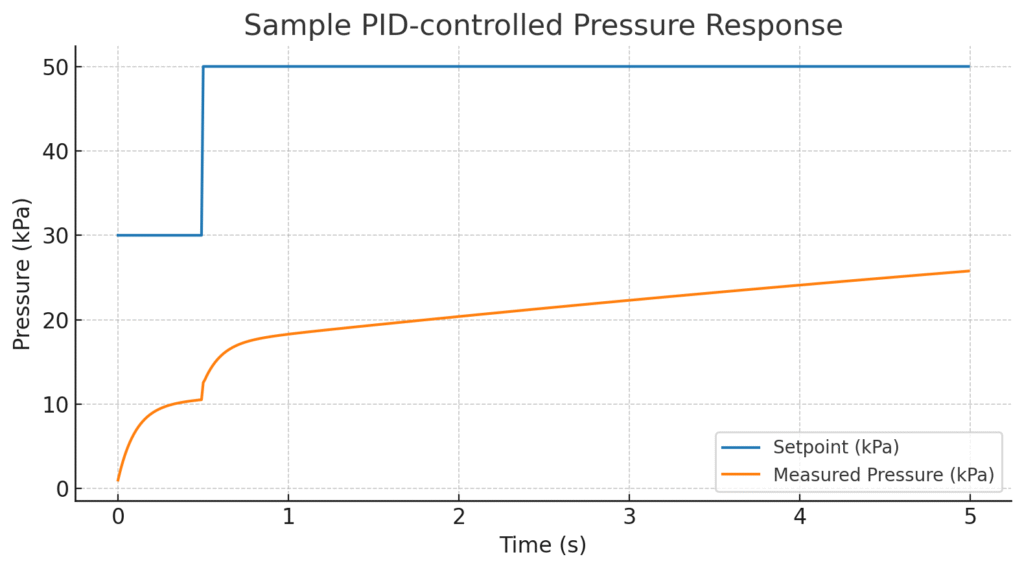ক্যাটালগ
High-resolution MEMS pressure sensors, when integrated into pneumatic caulking equipment, provide real-time pressure monitoring and closed-loop control. That stability keeps dispense volume steady, cuts material waste, and raises equipment reliability. Based on collected images and technical notes, this article explains sensor basics, precise dispense control, protection and safety features, automation integration, and energy and maintenance gains
1. MEMS Pressure Sensor Basics and How They Work
Sensing mechanism and signal flow
MEMS piezoresistive sensors use a silicon diaphragm that flexes under pressure. That flex changes embedded resistor values in a Wheatstone bridge. The bridge output is amplified and conditioned, then delivered as analog or digital output. Typical response is 1–5 ms and resolution can reach 0.05% FS. Interfaces commonly include I²C, SPI, and 4–20 mA, which plug directly into PLCs or MCUs for closed-loop control.
Packaging and electrical traits
Modern packages are compact, often ceramic or metal, with pins for power, ground, signal, and calibration. Many include a temperature sensor for onboard compensation. Typical supply voltages are 3.3 V or 5 V and power draw is low—suitable for handheld or line equipment. Mount sensors near the regulator or nozzle to reduce dead volume and speed response.

2. Precise Control of Sealant Output
Real-time pressure feedback and closed-loop control
Pressure sensors stream pressure curves to the controller. The controller adjusts pump power or valve position to hold setpoint pressure, keeping extrusion steady. This closed-loop removes effects of source fluctuations, line resistance, and temperature shifts. Target control accuracy of ±0.5% FS is realistic with a properly tuned loop, improving bead width and flow repeatability.
Material-adaptive pressure tuning
Different sealants need different drive pressures. The control system uses pressure rise, steady-state pressure, and optionally temperature to select the correct control profile. High-viscosity materials run at higher steady pressure; low-viscosity materials need lower pressure to avoid over-dispense. Automating profile call-up reduces manual setup and speeds changeovers.
Temperature compensation and environmental handling
Temperature affects sealant rheology and air properties. Built-in temperature compensation or a simple pressure–temperature matrix helps correct measurement drift and maintain consistent flow. Proper compensation keeps performance stable across a wide working range (roughly −20°C to +60°C in typical designs).
3. Equipment Protection and Safety Monitoring
Overpressure protection and emergency shutdown
Sensors trigger protection when pressure exceeds safe limits—common causes include nozzle clog, kinked hose, or cured material blocking flow. Set safety thresholds and a fast response path to stop pumps or close valves. Response times under 10 ms and clear fault logging protect equipment and operators from spray or mechanical failure.
Low-pressure alerts and supply checks
Low pressure indicates source issues or leaks and can ruin a run. Low-pressure alarms notify operators before quality suffers. Set low-pressure thresholds to avoid false alarms while still catching real faults. Monitoring pressure rise time gives a quick view of system sealing health.
4. Automation and Intelligent Integration
PLC integration and line-level control
MEMS sensors talk to PLCs over standard buses, providing live pressure and status. PLCs load product-specific pressure programs so the line can switch products with minimal delay. Multi-station coordination keeps bead quality consistent across work stations and simplifies production flow.

Data capture and process tuning
Store pressure trends, alarms, and event markers for offline analysis. Trend data helps spot nozzle wear, pump degradation, or material change. Use logged data to tune control parameters or build simple predictive models for maintenance planning. Aggregated data improves repeatability and reduces downtime.
5. Energy Efficiency and Equipment Life
On-demand pressure and energy savings
Instead of constant high-pressure supply, use demand-driven control: lower pressure in standby, ramp up only when dispensing. For intermittent work this can cut compressor runtime and energy use substantially—typical savings in the 20–30% range in many setups.
Wear reduction and maintenance scheduling
Stable pressure reduces shock loading on seals, valves, and fittings. Track pressure fluctuation patterns to identify components that are degrading. Condition-based maintenance guided by sensor data is more efficient than fixed-interval servicing and can extend component life by double-digit percentages.
উপসংহার
Using high-performance MEMS pressure sensors as the feedback core of pneumatic caulking equipment converts manual guesswork into repeatable, controllable process parameters. Real-time monitoring, closed-loop control, safety cutoffs, material-adaptive profiles, and data-driven maintenance together raise dispense consistency, safety, and energy efficiency. With correct mounting, sampling, filtering, alarm thresholds, and PID tuning, teams can deploy stable, production-grade caulking systems that scale from single tools to automated lines.
উপরের ভূমিকাটি শুধুমাত্র চাপ সেন্সর প্রযুক্তির প্রয়োগের পৃষ্ঠকে স্ক্র্যাচ করে। আমরা বিভিন্ন পণ্যে ব্যবহৃত বিভিন্ন ধরণের সেন্সর উপাদান, তারা কীভাবে কাজ করে এবং তাদের সুবিধা এবং অসুবিধাগুলি অন্বেষণ করতে থাকব। এখানে কি আলোচনা করা হয়েছে সে সম্পর্কে আপনি যদি আরও বিশদ জানতে চান, তাহলে আপনি এই নির্দেশিকায় পরে সংশ্লিষ্ট বিষয়বস্তু দেখতে পারেন। আপনি যদি সময়ের জন্য চাপ দেন তবে আপনি এই গাইডের বিশদ বিবরণ ডাউনলোড করতে এখানে ক্লিক করতে পারেন বায়ুচাপ সেন্সর পণ্য পিডিএফ ডেটা.
অন্যান্য সেন্সর প্রযুক্তি সম্পর্কে আরও তথ্যের জন্য, অনুগ্রহ করে আমাদের সেন্সর পৃষ্ঠা দেখুন.
